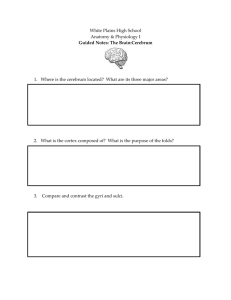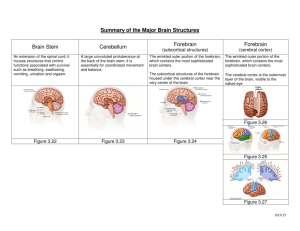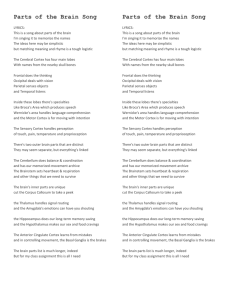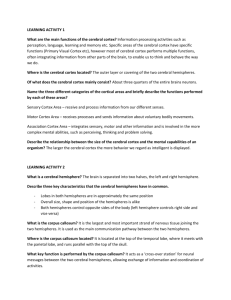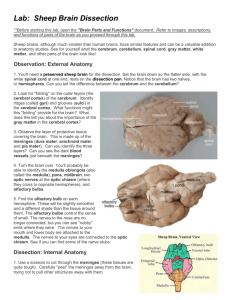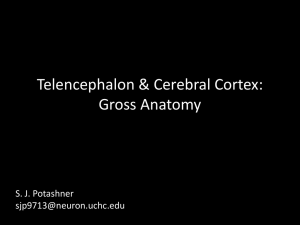Objectives - anatomyphysiologyrusso
advertisement
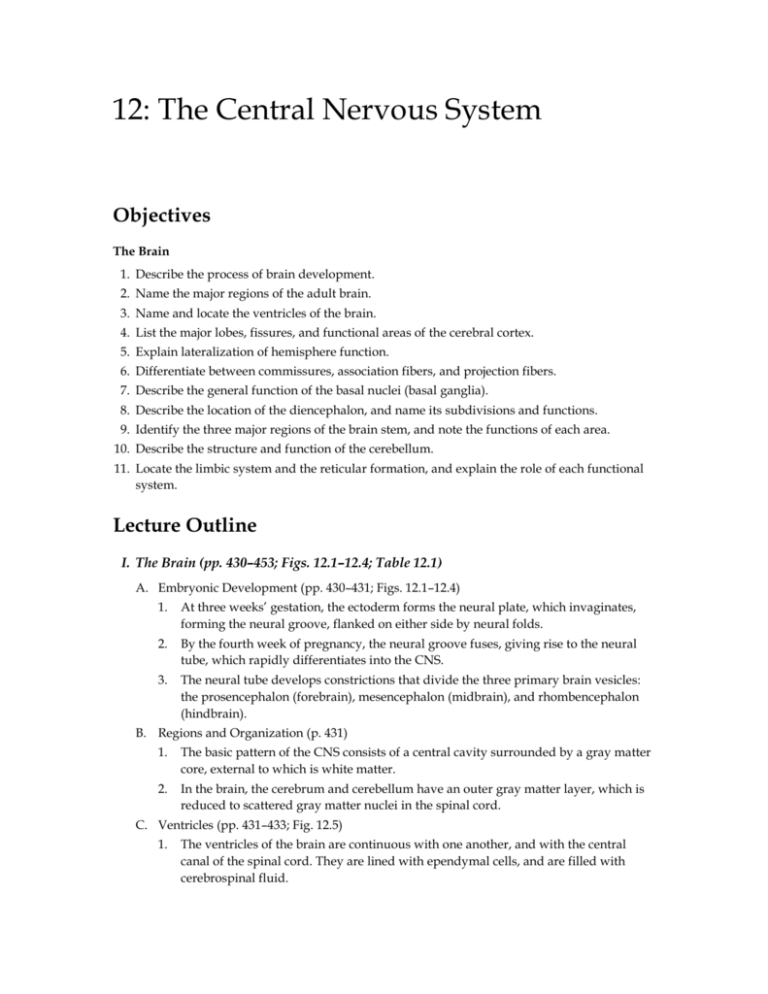
12: The Central Nervous System Objectives The Brain 1. Describe the process of brain development. 2. Name the major regions of the adult brain. 3. Name and locate the ventricles of the brain. 4. List the major lobes, fissures, and functional areas of the cerebral cortex. 5. Explain lateralization of hemisphere function. 6. Differentiate between commissures, association fibers, and projection fibers. 7. Describe the general function of the basal nuclei (basal ganglia). 8. Describe the location of the diencephalon, and name its subdivisions and functions. 9. Identify the three major regions of the brain stem, and note the functions of each area. 10. Describe the structure and function of the cerebellum. 11. Locate the limbic system and the reticular formation, and explain the role of each functional system. Lecture Outline I. The Brain (pp. 430–453; Figs. 12.1–12.4; Table 12.1) A. Embryonic Development (pp. 430–431; Figs. 12.1–12.4) 1. At three weeks’ gestation, the ectoderm forms the neural plate, which invaginates, forming the neural groove, flanked on either side by neural folds. 2. By the fourth week of pregnancy, the neural groove fuses, giving rise to the neural tube, which rapidly differentiates into the CNS. 3. The neural tube develops constrictions that divide the three primary brain vesicles: the prosencephalon (forebrain), mesencephalon (midbrain), and rhombencephalon (hindbrain). B. Regions and Organization (p. 431) 1. The basic pattern of the CNS consists of a central cavity surrounded by a gray matter core, external to which is white matter. 2. In the brain, the cerebrum and cerebellum have an outer gray matter layer, which is reduced to scattered gray matter nuclei in the spinal cord. C. Ventricles (pp. 431–433; Fig. 12.5) 1. The ventricles of the brain are continuous with one another, and with the central canal of the spinal cord. They are lined with ependymal cells, and are filled with cerebrospinal fluid. a. The paired lateral ventricles lie deep within each cerebral hemisphere, and are separated by the septum pellucidum. b. The third ventricle lies within the diencephalon, and communicates with the lateral ventricles via two interventricular foramina. c. The fourth ventricle lies in the hindbrain and communicates with the third ventricle via the cerebral aqueduct. D. Cerebral Hemispheres (pp. 433–441; Figs. 12.6–12.11; Table 12.1) 1. The cerebral hemispheres form the superior part of the brain, and are characterized by ridges and grooves called gyri and sulci. 2. The cerebral hemispheres are separated along the midline by the longitudinal fissure, and are separated from the cerebellum along the transverse cerebral fissure. 3. The five lobes of the brain separated by specific sulci are: frontal, parietal, temporal, occipital, and insular. 4. The cerebral cortex is the location of the conscious mind, allowing us to communicate, remember, and understand. 5. The cerebral cortex has several motor areas located in the frontal lobes, which control voluntary movement. a. The primary motor cortex allows conscious control of skilled voluntary movement of skeletal muscles. b. The premotor cortex is the region controlling learned motor skills. c. Broca’s area is a motor speech area that controls muscles involved in speech production. d. The frontal eye field controls eye movement. 6. There are several sensory areas of the cerebral cortex that occur in the parietal, temporal, and occipital lobes. a. The primary somatosensory cortex allows spatial discrimination and the ability to detect the location of stimulation. b. The somatosensory association cortex integrates sensory information and produces an understanding of the stimulus being felt. c. The primary visual cortex and visual association area allow reception and interpretation of visual stimuli. d. The primary auditory cortex and auditory association area allow detection of the properties and contextual recognition of sound. e. The olfactory cortex allows detection of odors. f. The gustatory cortex allows perception of taste stimuli. g. The vestibular cortex is responsible for conscious awareness of balance. 7. Several association areas are not connected to any sensory cortices. a. The prefrontal cortex is involved with intellect, cognition, recall, and personality, and is closely linked to the limbic system. b. The language areas involved in comprehension and articulation include Wernicke’s area, Broca’s area, the lateral prefrontal cortex, and the lateral and ventral parts of the temporal lobe. c. The posterior association area receives input from all sensory areas, integrating signals into a single thought. d. The visceral association area is involved in conscious visceral sensation. 8. There is lateralization of cortical functioning, in which each cerebral hemisphere has unique abilities not shared by the other half. a. One hemisphere (often the left) dominates language abilities, math, and logic, and the other hemisphere (often the right) dominates visual-spatial skills, intuition, emotion, and artistic and musical skills. 9. Cerebral white matter is responsible for communication between cerebral areas and the cerebral cortex and lower CNS centers. 10. Basal nuclei consist of a group of subcortical nuclei, which play a role in motor control and regulating attention and cognition. E. The diencephalon is a set of gray matter areas, and consists of the thalamus, hypothalamus, and epithalamus (pp. 441–445; Figs. 12.11–12.15; Table 12.1). F. 1. The thalamus plays a key role in mediating sensation, motor activities, cortical arousal, learning, and memory. 2. The hypothalamus is the control center of the body, regulating ANS activity such as emotional response, body temperature, food intake, sleep-wake cycles, and endocrine function. 3. The epithalamus includes the pineal gland, which secretes melatonin and regulates the sleep-wake cycle. The brain stem, consisting of the midbrain, pons, and medulla oblongata, produces rigidly programmed, automatic behaviors necessary for survival (pp. 445–450; Figs. 12.15–12.16; Table 12.1). 1. The midbrain is comprised of the cerebral peduncles, corpora quadrigemina, and substantia nigra. 2. The pons contains fiber tracts that complete conduction pathways between the brain and spinal cord. 3. The medulla oblongata is the location of several visceral motor nuclei controlling vital functions such as cardiac and respiratory rate. G. Cerebellum (pp. 450–451; Fig. 12.17; Table 12.1) 1. The cerebellum processes inputs from several structures and coordinates skeletal muscle contraction to produce smooth movement. a. There are two cerebellar hemispheres consisting of three lobes each. Anterior and posterior lobes coordinate body movements and the flocculonodular lobes adjust posture to maintain balance. b. Three paired fiber tracts, the cerebellar peduncles, communicate between the cerebellum and the brain stem. 2. Cerebellar processing follows a functional scheme in which the frontal cortex communicates the intent to initiate voluntary movement to the cerebellum, the cerebellum collects input concerning balance and tension in muscles and ligaments, and the best way to coordinate muscle activity is relayed back to the cerebral cortex. H. Functional brain systems consist of neurons that are distributed throughout the brain but work together (pp. 451–453; Figs. 12.18–12.19). 1. The limbic system is involved with emotions, and is extensively connected throughout the brain, allowing it to integrate and respond to a wide variety of environmental stimuli. 2. The reticular formation extends through the brain stem, keeping the cortex alert via the reticular activating system, and dampening familiar, repetitive, or weak sensory inputs.

